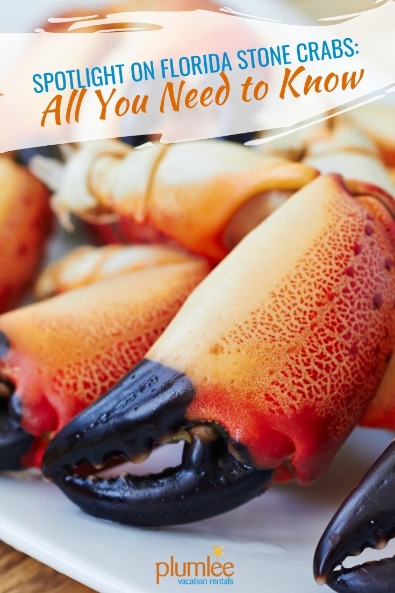
It’s that time of year again on Florida’s Gulf Coast! Yep, it’s the annually anticipated Stone Crab season which runs from October 15 to May 15. So what’s all the hype about? Good question! Here’s a quick run down on all you need to know about stone crabs and why they’re so popular. Have you had your stone crab fix yet? Whether you eat them at our fabulous local restaurants or bring them back to your Indian Rocks Beach vacation rental, they are sure to be enjoyed here, there and everywhere!
🦀 FUN FACTS ABOUT STONE CRABS
- The stone crab’s large claws can account for half its body weight. As a stone crab ages, the percentage of body weight may increase in the claws.
- Only the claws of stone crabs are harvested. The crab is put back in the Gulf of Mexico alive, where it regenerates a new claw.
- Stone crabs use shells as a tool to burrow into the sand. When you come across a stone crab home, it is often covered by shells.
- Female stone crabs produce up to a million eggs at a time, and will produce from four to six egg sacs, called sponges, in a single spawning season.
- The average life span of a stone crab is not known, but is estimated to be between seven and nine years in non-fished regions.
🦀 HARVESTING FLORIDA STONE CRABS
- Florida stone crab season is October 15 to May 15.
- Stone crab fisheries are closed during the summer to protect spawning females.
- Crabs are caught in baited traps in the Gulf of Mexico and nearshore estuaries.
- Frozen pigs’ feet is the choice crab bait when the water is warm, and mullet or sharks’ heads when the water is cooler.
🦀 BOAT TO TABLE GULF COAST SEAFOOD
- Known as Florida’s renewable seafood resource, only claws of at least 2 3/4 inches are harvested. The crab is returned alive to the Gulf of Mexico, where it typically takes a year to generate a new claw, and up to three years for it to reach legal size.
- Research from the Florida Fish & Wildlife Conservation Commission shows approximately 13% of the stone crab claws harvested are regenerated, indicating that stone crabs survive the declawing process.
- Southwest Florida crabbers work hard to harvest the delectable stone crab claws during the annual season. Claws harvested locally find their way to local restaurants and are also shipped fresh overnight to other Florida and national locations.
- Stone crab claws must be steamed immediately upon being brought to the dock and then chilled. This prevents the meat from sticking to the shell.
🦀 HOW TO EAT STONE CRABS
- Stone crabs are not cheap; expect to pay anywhere from $25-$100 for a stone crab meal, depending on the previous year’s harvest, amount purchased, and market prices.
- Claws are sold in fish markets based on size, and price per pound varies accordingly.
- Claws are traditionally served cold with a mustard dipping sauce or drawn butter. The taste is comparable to lobster.
- Here’s how to whip up the creamy mustard-based sauce that was made famous by Joe Weiss, founder of Joe’s Stone Crab in Miami. Whisk 1 cup mayonnaise, 2 Tbsp. half-and-half, 4 tsp. dry mustard, 2 tsp. Worcestershire sauce, and 1 tsp. A.1. Steak Sauce in a bowl until smooth; season with salt and pepper, and chill. Serve as a dipping sauce with all kinds of crab.
🦀 WHERE TO EAT STONE CRABS IN INDIAN ROCKS BEACH & INDIAN SHORES, FLORIDA
🦀 WATCH MORE ABOUT FLORIDA STONE CRAB SEASON ON THE GULF COAST
read more about florida stone crabs!
The Florida Fish and Wildlife Conservation Commission has more great information about Florida Stone Crabs. Check it out!






